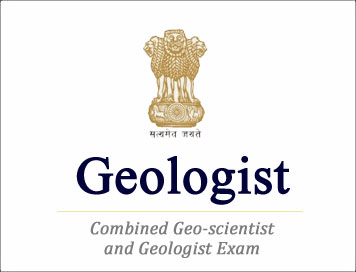(HOT) UPSC Current Affairs 2025 PDF
NEW! The Gist (NOV-2025) | E-BOOKS
(Download) UPSC: Geologist Examination Papers-2020 (Chemistry Paper - 1)

(Download) UPSC: Geologist Main Examination Papers-2020
(Chemistry Paper-I)
Exam Name : UPSC Geo-Scientist and Geologist Main Exam
Subject : UPSC Geo-Scientist and Geologist Main Exam Papers 2020 : Chemistry Paper- I
Year : 2020
Chemistry Paper - I
- Time Allowed : Three Hours
- Maximum Marks : 200
Q1. Answer all of the following: 5x10=50
(a) Fe3O4 adopts inverse spinel structure while Co3O4 adopts normal spinel structure. Explain.
(b) Explain Trans effect with suitable example.
(c) How is boric acid titrated using NaOH solution ?
(d) What is oxine ? Draw the structure of aluminium oxinate complex.
(e) Distinguish between iodometry and iodimetry.
(f) Small amount of magnesium chloride is added during the estimation of calcium by EDTA and solochrome black indicator. Justify.
(g) Write the structure of triiron dodecarbonyl. Mention the number of M-M bonds.
(h)Explain masking and demasking with reference to the complexometric titration.
(i) 53I133 is a beta emitter, while 53I121 is a positron emitter. Explain.
(j) Define transition elements. Is CuCl a transition metal compound ? Justify your answer.
SECTION B
Q2. Attempt any one question :
(a) Describe preparation, structure and properties of tetrasulphur tetranitride.
(b) What types of defects are shown by CaC12 and AgBr? Explain.
(c) Why are non-stoichiometric defects shown by the transition metal compounds ? Give examples.
Q3. (a) Explain the factors affecting the stability of a metal complex in solution.
(b) Sketch the splitting of d-orbitals in [Ni(CN)412- ion. Comment on the magnetic behaviour of the complex.
(c) Explain the intense purple colour of KMnO4.
SECTION C
Attempt any one question :
Q4. (a) Electronic spectrum of [Cu(H2O)6]2+ shows unsymmetric broad band. Justify.
(b) Assign the absorption bands observed at 10750, 17500 and 28200 cm-1 in the electronic spectrum of [Ni(NH3)6]2+. Calculate ligand field parameters, 10Dq, B', B, B0% and LFSE. Give significance of these parameters. The value of B for free gaseous nickel metal ion is 1060 cm-1
Q5. (a) Which indicator is employed in the titration of hydrochloric acid versus ammonium hydroxide ? Explain with suitable neutralization curve.
(b) Outline the principle as used in determination of NaHCO3 and Na2CO3 in a mixture.
(c) Mention the underlying principle for the gravimetric determination of nickel using dimethylglyoxime. Draw the structure of the complex.
SECTION D
Attempt any one question :
Q6. (a) Distinguish between solubility and solubility product citing suitable example.
(b) What do you mean by co-precipitation and post-precipitation ? Explain giving suitable example in each case.
(c) What is Zimmermann-Reinhardt solution ? Explain its role in the titration of Fe2+ ion with KMnO4 in HCl medium.
Q7. (a) Consider the redox titration of Fe2+ ion by Ce4+ ion in dilute H2SO4 medium at 298 K.
Ce4+ + Fe2+ Ce3+ + Fe3+
Calculate the equilibrium constant of the above reaction. Comment on the feasibility of the above titration. Draw the titration curve and suggest a suitable indicator to detect the equivalence point of the titration.
[Given : Ce4+ + - = Ce3+ E° = 1.44 V
Fe3+ + € = Fe2+ E° = 0.77 V]
(b) The standard reduction potentials of the Ni2+/Ni and Co2+/Co couples are - 0.25 V and - 0.277 V respectively. Comment on the feasibility of the following reaction at 298 K.
Ni2+ + Co Ni + Co2+
SECTION E
Attempt any one question :
Q8. (a) Explain the three different types of EDTA titrations.
(b) Define hardness of water. Give the outline of the procedure for the determination of total hardness of water using EDTA.
Q9. (a) Define metallochromic indicators. Explain the mechanism of colour change in the complexometric titration with suitable example.
(b) Write the catalytic cycle for the hydrogenation of propene by [RhCI(PPhz)3]. Write the drawback of this catalyst.
SECTION F
Attempt any one question : 40
Q10. (a) Calculate the packing fraction, mass defect and energy released in the formatin of Argon atom18 Mention the significance of the packing fraction so calculated.
[Given : mass of proton = 1.007825 a.m.u.
mass of neutron = 1.008665 a.m.u.
isotopic mass of Ar = 39.962384 a.m.u. 1 a.m.u. = 931.5 MeV]
(b) Calculate magnetic moment of Pr2(SO4)3 · 8H2O and compare it with spin-only value. Justify the observed deviation. (Atomic number of Pr is 59)
(c) Complete the following nuclear reactions :
(i) 11Na24 → ___ +-1e0
(ii) 13A127 + 0n1 → __+ 2He4
Q11. (a) Why do the transition metals show a large number of oxidation states ? Write all the oxidation states of chromium and manganese and mention the most stable state.
(b) How do ionic radii vary in the lanthanide series ? Describe separation of lanthanide ions by ion exchange method.
(c) Compare NiC142- ,PdC142- and PtC142-, with respect to structure and magnetic properties.
(d) AmO22+ is oxidizing while Bk3+ is reducing in nature. Explain.

